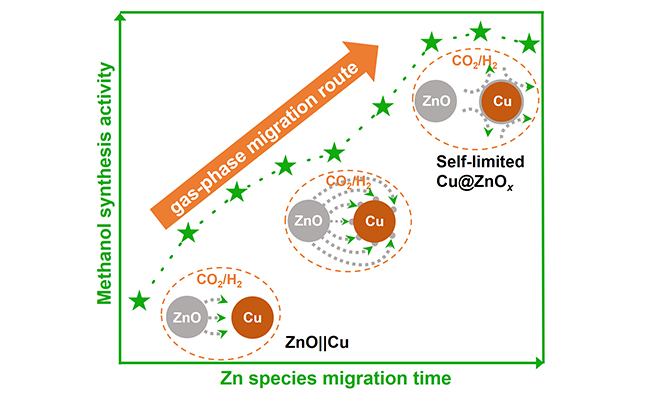Strong metal-support interaction (SMSI) is one of the most important concepts in heterogeneous catalysis. Triggered by pretreatment or reaction processes, the supported metal nanoparticles may be partially or completely encapsulated by support-derived overlayers, which impact the catalytic performance of supported metal catalysts. However, the formation mechanism of the SMSI state is still unclear.
Recently, a research team led by Prof. FU Qiang from the Dalian Institute of Chemical Physics (DICP) of the Chinese Academy of Sciences (CAS) proposed a gas-phase migration route for the formation of SMSI.
This work was published in Angewandte Chemie International Edition on Dec. 11.

Schematic illustration of the formation of self-limited Cu@ZnOx structure via gas-phase migration route and its effect on CO2 hydrogenation to methanol over Cu/Al2O3 catalysts (Image by SONG Tongyuan)
So far, two diffusion routes of the support-derived species onto the metal surface have been suggested, including interface alloying and surface migration.
In this work, the researchers placed ZnO particles and Cu/Al2O3 powders in a microreactor in a dual-bed mode (ZnO||Cu/Al2O3). By utilizing gas-phase migration of Zn species in CO2/H2 atmosphere (0.5% CO2/H2, 450°C), they found a self-limited thin ZnOx overlayer grew on the surface of Cu nanoparticles (Cu@ZnOx) in the Cu/Al2O3 catalyst without excessive deposition and aggregation of ZnOx species. Thus, they obtained an optimal number of ZnOx-Cu interface sites, which enhanced the methanol synthesis activity.
Moreover, the researchers demonstrated that the formation of the self-limited Cu@ZnOx encapsulation structure was due to the evaporation of Zn atoms from the ZnO particles, migration to the Cu/Al2O3 catalyst, and further deposition onto the Cu surface to form ZnOx overlayers under the synergistic effect of reducing H2 and oxidizing CO2 components at the treatment temperature.
"Our work elucidates the high temperature redox atmosphere-induced gas-phase migration route to the formation of the encapsulation structure or the classic SMSI state," said Prof. FU.
This work was supported by the National Key R&D Program of China, the National Natural Science Foundation of China, and the Photon Science Center for Carbon Neutrality.